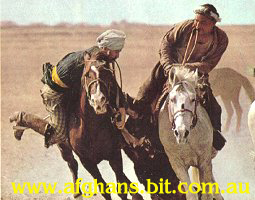
While re-establishing Safavid rule in Persia, Nadir Quli Beg had Perforce to contend
with Abdali incursions into Persian territoriy from the area of Herat and when, even
after defeat, the Abdali's persisted in stirripng up periodic revolts, an exasperated
Nadir moved their leaders away from Herat to Persia where they were given lands and
prospered. Not a few sebsequently rendered valueable assistance to Nadir in his
battles at home, so valueable in fact that at one point he promised them any boon they
asked. Shrewdly assessing the current situation and wisely looking to the future, they
(Abdali's) asked only that be returned to their ancesteral lands in Kandahar. The
Ghilzai-Abdali feud still fastered and Nadir cunningly promised them their request.
Following the patterns establised by successful adventurers before him, Nadir soon
tired of fighting on behalf of Safavid Danysty and raised himself to the throne of Persia
in 1736, stylying himself Nadir Shah Afshar. Two years later he set out to deliver the
final blow to the Ghilzai. He headed toward Kandahar and the Abdali marched with
him.
At Kandahar Mir Wais's second son, Husain, had ruled with comperative peace and
honor while relatives proceeded on their conquest of Persia. Now the Kandaharis
stood stoutly behind him in defence and the city held out for one year before giving
way in March 1738. In the extensive ruins Zor Shar, the Old City of Kandahar below
the cliffs of the Chihlzina, one can still see the high citadel of massive fortification walls
which made it so difficult to capture. Nadir Shah abondoned the city he destroyed and
built a new city named Nadirabad to the south-east of Old Kandahar. Described by
contemporaries as a "mean substitude" little remain to be seen of Nadirabad today.
Of lasting importance, however, was Nadir Shah's fulfillment of a promise. An Abdali
chieftain was appointed governer of Nadirabad and Abdali tribesmen swarmed in from
Persia to occupy Ghilzai land between Kandahar and Herat.
Nadir Shah also released several Abdali from Kandahar's prisons, one of whom was
Ahmad Khan Sadozai, the young 16 year old son of prominant Abdali chieftain.
Joining the Persian forces as a lowly orderly, the boy attracted the approving eye of
the conquerer as the army moved through Kabul, on to the overthrow of the Moghul
Dynasty in Delhi. Rising rapidly as a consequence, Ahmad Khan was appointed
commander of 4,000 Afghans froming the Shah's personal body guard and trusted
guardian of the treasury. But in June of 1747 a group of his Persian Officers
assassinated Nadir Shah Afshar, and the Ahmad Khan and his troops were forced to
flee, for the Persians resented and feared Afghans. Making his way to Kandahar,
Ahmad Khan joined a tribal council at the shrine of Sher Surkh, in the suburbs of
Nadirabad. All at the council recognized that the time for independence had never
been more favorable.
Ghilzai power was broken; Husain and most of their leaders were in exile in Persia.
The important division at Kandahar was now drawn between two Abdali groups, the
Popalzai and the Barakzai. Haji Jamal Mohammedzai of the Barakzai was chief of the
majority group, but Ahmad Khan Sadozai of the Popalzia, on the other hand, though
25, had distinquished himself as a leader with Persians. Moreover, he was the leader
of a strong force of experienced fighting men, and, most significantly, he had the wealth
of Nadir's treasury, including the Koh-i-Noor diamond, and a recently camptured
caravan carrying confiscated Moghul treasure from Delhi.
One of the more important events in Afghan history occured when Haji Jamal stepped
down in favor of Ahmad Khan. In a simple coronation a sheaf of wheat was placed on
his head as a crown and Ahmad Khan became Ahmad Shah. The stage was set for
the creation the last genuine Afghan empire.
Several compaigns against the tottering Moghuls of Lahore and Delhi (1747-1769)
and Kashmir (1752) alternating with compaigns against Kabul (1747), Herat,
Maimana and eastward through Badakhshan (1749) won for Ahmad Shah an empired
and the title by which he is fondly known in Afghanistan, Ahmad Shah Baba, the father
of Afghanistan.
Cancer of face resulting from a nose wound incurred during a battle in India brought
the life this remarkable man to a close at the age of 50 in 1772 and at once it seemed
as though fraternal jealeousies must surely undo all he had achieved. At Kandahar the
city which Ahmad Shah himself laid out to replace Nadirabad, the blue-domed
mausoleum of Ahmad Shah Baba towers over the city, a reminder of those days of
glory when Kandahar was the capitol of an empire. In the charming village of Sher
Surkh, south-east of of the city, Ahmad Shah Baba raised a dome over the saint's
tomb where he had been crowned. This rustic shrine symbolizes the simple beginning
of a tribal cheif; the highly ornate mausoleum commemorates the accomplisements of
an empire builder Ahmad Shah Baba.
|


